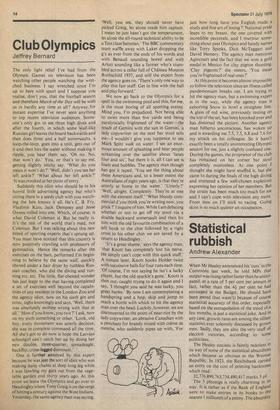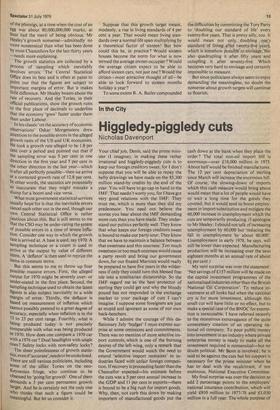Statistical rubbish
Andrew Alexander When Mr Healey announced his 'cuts' in the Commons last week, he told MPs that output was rising rather faster than he anticipated, at a rate of 5 per cent per annum In fact, rather than the 41 per cent he had envisaged in the Budget. He should have been jeered (but wasn't) because of course statistical accuracy of this order, especiallY based on the extrapolation of the trend of .a few months, is just a statistical joke. And lb any case, growth rates are among the silliest statistics ever solemnly discussed by grown men. Sadly, they are also the very stuff oi election victories, according to some
politicians. ..„ The Healey statistic is faintly redolent in its way of some of the statistical absurdities which became so obvious in the Weimar Republic. In 1923, the Reichsbank carried an entry on the cost of printing banknotes which read:
32,776,899,763,734,490,417 marks 5 pf.
The 5 pfennigs is really charming in its way. It is rather as if the Bank of England were to make entries in its books to the nearest 1 millionth of a penny. The absurditY of the pfennigs, at a time when the cost of an egg was about 80,000,000,000 marks, at least had the merit of being obvious, Mr Healey's growth nonsense—admittedly no more nonsensical than what has been done by most Chancellors for the last thirty years —needs more explaining.
The growth statistics are collected by a Process of sampling which inevitably Involves errors. The Central Statistical Office does its best and is often at pains to Point out that the figures are subject to IMportant margins of error. But it makes little difference. Mr Healey boasts about the rate of recovery. And the Tories, in their Official publications, show the growth rates to the first place of decimals to underline that the economy 'grew' faster under them than under Labour.
In his classic 'on the accuracy of economic Observations' Oskar Morgenstern drew attention to the possible errors in the alleged growth rates of the US and UK economies. He took a growth rate alleged to be 1.8 per cent over a period and pointed out that if the sampling error was 5 per cent in one direction in the first year and 5 per cent in the other direction in the last year—which Is after all perfectly possible—then we arrive at a corrected growth rate of 12.8 per cent. In other words, the statistics are potentially so inaccurate that they might mistake a Slump for a boom and vice versa.
What most government statistical services usually hope for is that the inevitable errors cancel each other out in the end, though our OW l Central Statistical Office is rather scautious about this. But it still seems to me that the CSO may be under-rating the extent of Possible errors in a time of severe inflation. Consider one way in which the growth rate is arrived at. A base is used, say 1970. A sampling technique or a count is used to arrive at the output by value of different Items. A 'deflator' is then used to reprice the items in constant terms.
But this seems to me to throw up four Possible massive errors. First, the alleged output for 1970 might be severely overor Understated in the first place. Second, the sampling technique used to obtain the latest figures is also subject inevitably to a wide Margin of error. Thirdly, the deflator is based on measurement of inflation which cannot possibly pretend to a great degree of accuracy, especially when inflation is in the 5.to 25 per cent range. Fourthly, what is being produced today is not precisely Comparable with what was being produced M.1970. How does one compare a 1970 car with a 1976 car ? Dual headlights with single ones? Safety locks with non-safety locks? The sheer pointlessness of growth statistics, even if 'accurate', needs to be underlined. There are still various politicians, including some of the sillier Tories on the neoKeynesian fringe, who continue to be Obsessed by 'going for growth'. One of them demands a 5 per cent permanent growth target. And he is certainly not the only one Who thinks that such a figure could be meaningful. But let us consider it.
Suppose that this growth target meant, modestly, a rise in living standards of 4 per cent a year. That would mean living standards over a normal life span multiplying by a theoretical factor of sixteen! But how could this be, in practice ? Would sixteen houses become the norm for what is now termed the average owner-occupier ? Would the average citizen expect to be able to afford sixteen cars, not just one? Would the citizen—most attractive thought of all—be able to look forward to sixteen months holiday a year ?
To some extent R. A. Butler compounded the difficulties by committing the Tory Party to 'doubling our standard of life' every twenty-five years. That is pretty silly, too. It would mean not only doubling one's standard of living after twenty-five years, which is somehow possible to envisage, but also quadrupling it after fifty years and octupling it after seventy-five. Which becomes very hard to envisage and certainly impossible to measure.
But since politicians always seem to enjoy demanding the meaningless, no doubt the nonsense about growth targets will continue to flourish.



































 Previous page
Previous page